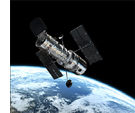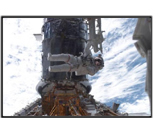 Launched
in April of 1990 and poised for many more years of trailblazing science
ranging from our own solar system to the edge of the observable universe,
NASA’s Hubble Space Telescope is fulfilling the hopes
astronomers have long held for a large, optically superb telescope
orbiting above the Earth’s distorting atmosphere and providing
uniquely clear and deep views of the cosmos. Launched
in April of 1990 and poised for many more years of trailblazing science
ranging from our own solar system to the edge of the observable universe,
NASA’s Hubble Space Telescope is fulfilling the hopes
astronomers have long held for a large, optically superb telescope
orbiting above the Earth’s distorting atmosphere and providing
uniquely clear and deep views of the cosmos.
The only one of NASA’s four “Great Observatories”
(Hubble, Compton Gamma-Ray Observatory, Chandra X-Ray Observatory,
and Spitzer Space Telescope) that is serviceable by Space Shuttle
astronauts, Hubble has seen its capabilities grow immensely in its
sixteen historic years of operation. This has been the direct result
of the installation of new, cutting-edge  scientific
instruments and more powerful engineering components. Replacement
of aging or failed parts has been an important part of servicing
and has been responsible for the telescope’s longevity. scientific
instruments and more powerful engineering components. Replacement
of aging or failed parts has been an important part of servicing
and has been responsible for the telescope’s longevity.
All of the Great Observatories have a particular range of light,
or “electromagnetic radiation,” to which they are designed
and are sensitive. Hubble’s domain extends from the ultraviolet,
through the visible (to which our eyes are sensitive), and to the
near-infrared. In terms of the wavelength of light, Hubble’s
coverage ranges from 1,200 Angstroms in the ultraviolet (1 Angstrom
= 1 hundred-millionth of a centimeter) to 2.4 microns (24,000 Angstroms)
in the near-infrared. Hubble’s UV-to-near-IR spectral range
is a key piece of “astronomical real estate” — a
dominant range of wavelengths emitted by stars and galaxies —
and Hubble takes advantage of this access with both imaging and
spectroscopy.
|
|